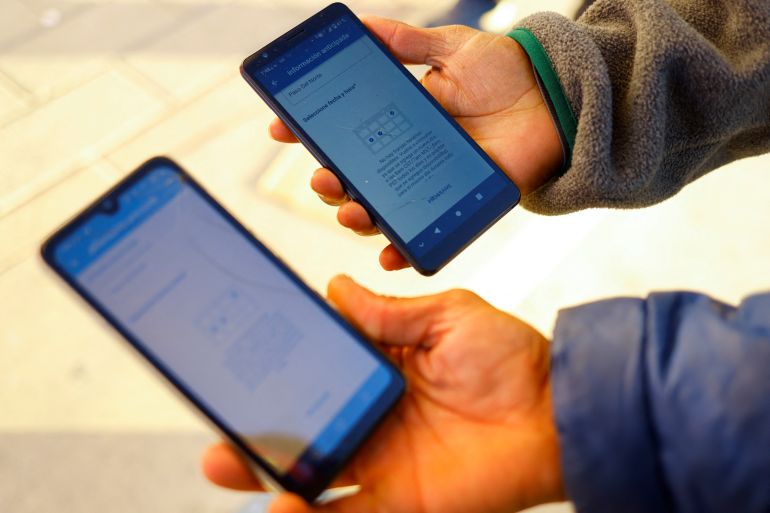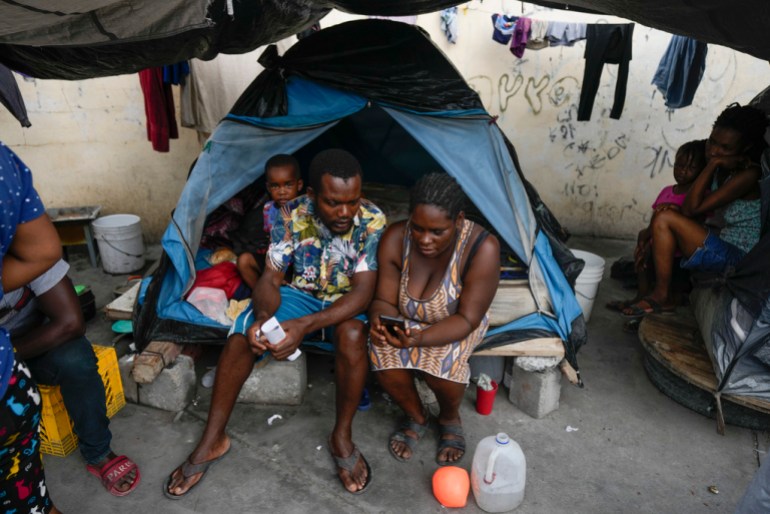‘It doesn’t work’: Migrants struggle with US immigration app
Asylum seekers say they are crossing US-Mexico border irregularly after failing to get appointments through CBP One app.

Tijuana, Mexico – Standing in a common area of the Casa del Migrante shelter in the Mexican border city of Tijuana, Maria taps her phone screen but can’t get the app she is using to work.
Maria and her family fled their native Haiti to Venezuela years ago. But recent Venezuelan economic and political instability forced them to leave that country, too, and she said they are now hoping to apply for asylum in the United States.
Keep reading
list of 3 itemsTitle 42 is about to expire in US. Here’s what you need to know
Confusion, resolve at US-Mexico border as Title 42 formally ends
But she and her husband and daughter have tried every day for the last month to get a US immigration appointment through the country’s new CBP One app — to no avail.
And without a CBP One appointment, the family faces steep consequences should they try to cross the border irregularly, including being deported back to Haiti and barred from entering the US for up to five years.
Maria, who did not want her last name published because she feared it would affect her immigration case, says she doesn’t want to risk it. She is willing to wait in Mexico for as long as it takes.
“Cross the border illegally? No,” she tells Al Jazeera in Spanish. “If we enter the US illegally, we will be deported.”
US policies
The CBP One app was launched in October 2020. Earlier this year, the administration of US President Joe Biden announced it would transition the process of scheduling immigration appointments to the platform, in order to create a “safe, orderly and humane border processing” system amid an influx of arrivals.
The application’s use has become more important as a pandemic-era US policy known as Title 42 ended just before midnight on May 11, ushering in new rules that the administration says aim to encourage people to take “legal pathways” to immigration while punishing those who do not.
For asylum seekers in Mexico seeking to reach the US, the app is the main pathway to get an immigration appointment at a port of entry.
But CBP One has come under fire for its errors and bugs, and migration rights advocates have said the system does not take into account the conditions asylum seekers who reach the US border find themselves in.
Many do not have smartphones, or access to robust internet connections. Others have struggled to complete the app’s many requirements before confirming an appointment and watched as available slots quickly filled up.
Last week, as Maria’s tech-savvy teenage daughter took her mother’s phone to try to make an appointment, many of these problems were immediately clear.

Her daughter entered her username, password and a unique code, and told the app she is a traveller and wants to arrive at a land border. She completed several more steps and then selected the option to make an appointment. But when she tried to select a port of entry, the app would not let her select San Ysidro, the closest option for her.
Previously, when Maria used the app, she made it to the end of the process and CBP One asked her to take a photo. But she said the app will only capture your face if you are very fast, or else it freezes and sends you back to the beginning. The Wi-Fi at the shelter is weak, making the process even more difficult.
Migrant advocates also say the app has few language options — when Maria used CBP One on May 11, it only offered English, Spanish and Haitian Creole — and has trouble recognising photos of people with darker skin.
‘It doesn’t work’
US Customs and Border Protection (CBP) has said it is making changes to the app, including increasing the number of available appointments to 1,000 each day, and will prioritise people who have waited the longest.
On May 11, Department of Homeland Security (DHS) Secretary Alejandro Mayorkas said the US had admitted about 740 people through the CBP One app per day, and the majority were Haitian.
“The greatest challenge with respect to the CBP One app is not a technological challenge but rather the fact that we have many more migrants than we have the capacity to make appointments for,” Mayorkas said.
“The greatest level of frustration is actually being able to make the appointment, not the utility of the CBP One app itself. That is again another example of a broken immigration system.”
But Erika Pinheiro, executive director of Al Otro Lado, which provides legal and humanitarian support for refugees in Tijuana and the US and works with many Haitian migrants, said the organisation had seen most migrants struggle with the app itself. “It doesn’t work,” she said.
Right now, there are 100's of asylum seekers trapped bt the border walls waiting to be processed by Border Patrol agents who have left them their to languish for days with little food or water. People are sick from being left out in the cold. There are babies who need formula. pic.twitter.com/pk8UowKcIb
— Al Otro Lado (@AlOtroLado_Org) May 12, 2023
She told Al Jazeera that CBP One functions best with newer phones and a strong internet connection, but many migrants have older mobile phones and live in shelters or camps outside without strong internet access.
“Even if everything’s working perfectly, there’s not enough appointments for the number of people who want them,” Pinheiro said. “So by definition, you’re going to see a lot of frustrated people.
“The app in general is contrary to everything we know about asylum. Whether or not you have this life-saving protection shouldn’t depend on the type of cell phone you have, or whether you have an internet connection, or whether you’re tech savvy.”
Algorithms
Pinheiro also told Al Jazeera that she has witnessed people with darker skin trying to use the app, but it won’t recognise their photos. “I’ve seen darker-skinned individuals trying to take the photo, and our staffers have seen that, as well. It works a little bit better if they’re in super bright light or super bright sunlight.”
Meredith Broussard, a data journalist and author of several books on bias in the tech sector, said it was unsurprising to hear reports of people not being recognised on the app due to their skin tone.
Machine learning algorithms are fed large amounts of training data that they then use to make models that can make predictions or decisions, Broussard explained.
Facial recognition algorithms are trained on large photo sets, but if these do not include a range of skin tones, the model will be better at recognising the kinds of faces that dominate the training data, she said.
She added that “you can’t say empirically that this is what’s happening with this particular app without doing more testing”, however.
Still, given the known issues with bias in algorithms in general, she said there should be an efficient mechanism for people to use when the apps fail. “We need people working at the borders to deal with the inevitable technological failure,” Broussard said.
Frustrations persist
Currently, it is not clear if there is a backup system for when the CBP One app fails.
CBP did not immediately respond to a list of questions from Al Jazeera about the app, including what would happen if someone arrived at a point of entry trying to get an appointment without having used the app.
However, migrants and refugees at the US-Mexico border told Al Jazeera last week that when the app failed to give them an appointment, they decided to cross irregularly.
Yerman, a young man from Cali, Colombia, and his wife spent two nights sleeping on the ground between the US and Mexico border walls, waiting for US border authorities to process them. (Two walls run along the US-Mexico border with a narrow strip of land in between that is US soil.)
Yerman, who did not want his last name published due to privacy concerns, said they wanted to go to the US because of widespread violence and economic problems in their home country.
He said they took several flights through various countries until they arrived in Tijuana. They tried to use the CBP One app to make an appointment, but it kept giving them error messages, he said.
As a result, they made the decision to cross the border from Tijuana by walking around the wall on the Mexico side. He told Al Jazeera he was frustrated with the system: If the app functioned, they would not have tried to get to the US this way.